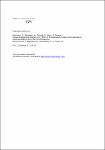Human endogenous retrovirus K (HERV-K) is expressed in villous and extravillous cytotrophoblast cells of the human placenta
Kämmerer, U.
Germeyer, A.
Stengel, Sven
Kapp, M.
Denner, Joachim
Human endogenous retroviruses (HERVs) have been shown to be important in physiological and pathophysiological processes in humans. Several HERVs have been found to be expressed in the placenta—a tissue with special immunomodulatory functions that is responsible for nutrition of the embryo and the ability of the semiallogenic trophoblast to invade. The envelope proteins of HERV-W (also known as syncytin 1) and HERV-FRD (syncytin 2) were shown to be involved in cell fusion leading to the generation of the syncytiotrophoblast. Syncytin 2 was further shown to have immunosuppressive properties. Herein we analyse the expression of another HERV, HERV-K, which is characterised by open reading frames for all viral genes. Using immunohistochemistry and Western blot analysis, expression of the transmembrane envelope (TM) protein of HERV-K was studied in normal placental and decidual tissues obtained at different gestational ages. The TM protein was expressed exclusively in villous (VT) and extravillous cytotrophoblast (EVT) cells, but not in the syncytiotrophoblast or other cells. The expression of the TM protein of HERV-K in EVT cells was confirmed by Western blot analysis of isolated c-erbB2-expressing cytotrophoblast cells. Thus, this is the first report showing expression of the TM protein of HERV-K in normal human placental tissue with an exclusive expression in cytotrophoblast cells, suggesting a potential involvement of HERV-K in placentogenesis and pregnancy. Since retroviral TM proteins including the TM protein of HERV-K have immunosuppressive properties, expression of the TM protein of HERV-K may contribute to immune protection of the fetus.
No license information

